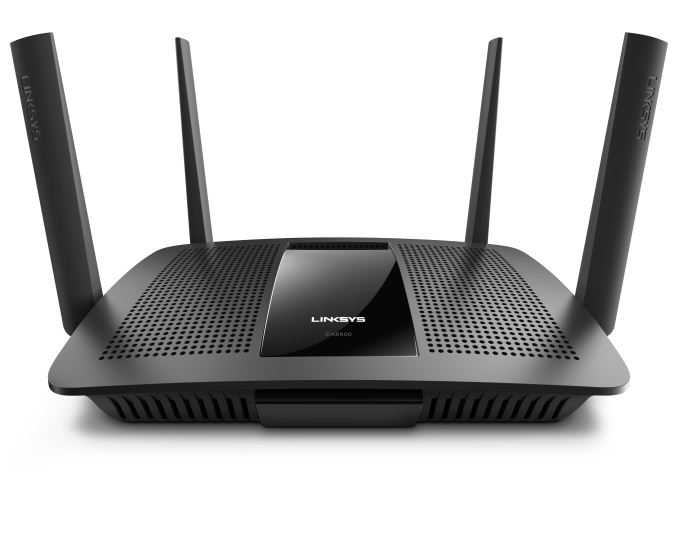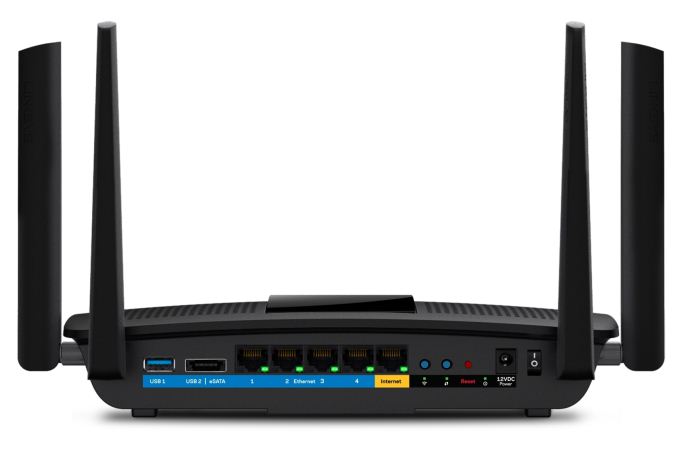Linksys EA8500 - First MU-MIMO Enabled 802.11ac Router Set to Ship
by Ganesh T S on May 7, 2015 7:00 AM EST- Posted in
- Networking
- Linksys
- 802.11ac
- Wi-Fi
- Qualcomm Atheros

Readers following our wireless networking coverage must be quite familiar with the developments in 802.11ac land. As a recap:
- The first 3-stream 802.11ac routers (based on the Broadcom BCM4706 chipset) started shipping in May 2012, with Buffalo Technologies and Netgear leading the way. There were marketed as AC1750 units (3x3 5 GHz providing up to 1300 Mbps and 3x3 2.4 GHz providing up to 450 Mbps). The street pricing of the AC1750 routers started to go down once Qualcomm started shipping their first-generation 802.11ac router platforms in products such as the TP-LINK Archer C7 in April 2013.
- In Q4 2013, a wave of AC1900 units started to hit the market. Netgear's Nighthawk R7000, a popular member in this series, still continues to sell well in the market. These units still used a 3x3 5 GHz radio for up to 1300 Mbps, but the 2.4 GHz had some proprietary Broadcom extensions (TurboQAM) to support up to 600 Mbps in an end-to-end Broadcom environment.
- In 2014, Quantenna began to bring their technology lead in the Wi-Fi space to the market with their Wave 2 4x4 802.11ac chipset. Despite being announced at CES 2014, the Asus RT-AC87U began to ship in July with the QSR1000 radio coupled with a Broadcom SoC. Netgear started to ship the same radio coupled with a Qualcomm IPQ8064 SoC in the Nighthawk X4 in September 2014. The QSR1000's Wave 2 feature set includes support for MU-MIMO, but neither of these routers shipped with MU-MIMO enabled in the firmware (citing lack of client support at that point of time). Given the 4x4 configuration, these routers were tagged as AC2350 / AC2400 units (600 Mbps in the 2.4 GHz band and 1733 Mbps in the 5 GHz band)
- In the midst of these Wave 2 product launches, Qualcomm announced plans for their Wave 2 802.11ac platforms (both routers and clients) in April 2014. Broadcom, being late to the Wave 2 party, decided to bring out the XStream platform with dual 5 GHz radios (six-stream configuration) also in April. They were able to get it quickly into the market too, with the Netgear Nighthawk X6 R8000 becoming available in June 2014.
- At CES 2015, we saw the first set of routers based on Qualcomm's QCA9880 4x4 Wave 2 802.11ac router platform getting announced. Vendors such as TP-LINK and TRENDnet were expecting their AC2600 class routers to ship towards the middle of the year.
Coming back to today's announcement regarding the EA8500, Linksys is becoming the first vendor to start shipping a QCA9980-based router. The important aspect here is that the router will ship with MU-MIMO enabled. Client devices with MU-MIMO enabled are also coming into the market just now (more on that in our detailed review). Hopefully, this announcement will spur both Netgear and Asus to enable MU-MIMO in the firmware for their Quantenna-based routers.
The salient features of the EA8500 router are listed below:
- 4x4 802.11ac with MU-MIMO and beamforming support
- QCA9980 radio + 1.4 GHz dual-core IPQ8064 SoC
- Simultaneous dual-band operation (5 GHz 802.11ac - 1733 Mbps, 5 GHz 802.11n - 600 Mbps, 2.4 GHz 802.11n - 800 Mbps)
- 1x USB 3.0, 1x USB 2.0 / eSATA
- 4x 1Gbps LAN, 1x 1Gbps WAN
- Adjustable antennas for optimal performance
One important point to note is that MU-MIMO capabilities will translate into real benefit only when there are multiple MU-MIMO-capable client devices talking to the router simultaneously. This will probably be a common scenario in enterprise Wi-Fi deployments soon. However, in a typical household, we would imagine that a situation involving multiple MU-MIMO clients is probably at least a good year away. Qualcomm is targeting an end-to-end play here, as the announcement made last year included a number of products in the client space with MU-MIMO capabilities.
Linksys is accepting pre-orders at $280 for the EA8500 today with shipments slated for May 10, 2015. Wide retail and e-tail availability is also expected starting next week. There is no doubt that MU-MIMO will be the most efficient way to boost Wi-Fi performance in the near future, and it is good that Linksys and Qualcomm are teaming together to accelerate its market adoption.
Source: Linksys











83 Comments
View All Comments
Uplink10 - Thursday, May 7, 2015 - link
If that is true it is O.K., but I am still unsure about that.CoreLogicCom - Thursday, May 7, 2015 - link
In order to get max performance from one of the AC routers, you have to have a very specific setup. For example, you absolutely have to be using the 5Ghz side, you must enable wide channels (160 for Wave 2 I believe), and you probably have to do some bit rate tuning, such as making 48Mbps Mandatory and 54Mbps supported just to get all the B-radio legacy beacons to stop being used by clients for associating. Remember also that any W-Fi network is (1) only as fast as the slowest client, and (2) is HALF Duplex to only one client at a time, and (3) is Collision Aware (CA) not Collision Detecting (CD), and (4) is a shared medium that you can only slice up for so many clients. In other words these numbers used by manufacturers are all marketing crap, and anyone who buys a router based on the speeds given probably bought Pentium 4's based solely on clock speed differences.hanssonrickard - Sunday, May 10, 2015 - link
CorelogicCom - What you write is mostly true for wifi, but an router also gives you the possibility to conenct using ethernet cables and in that case you get gigabit in both directions.tuxRoller - Saturday, May 9, 2015 - link
What are you uncertain about?That gigabit ethernet is full duplex (it is, since 801.3x)?
It's a pretty simple fact.
hanssonrickard - Sunday, May 10, 2015 - link
As wtallis wrote, 1Gb is full duplay, the only scenario where half dupley can or would ever be used with Gigabit is if it were connected to an hub. But for switches, full duplex is the only supported mode according to gigabit specifications.You have 1 gigabit in each direction if you have an gigabit card.
UtilityMax - Tuesday, May 12, 2015 - link
Seriously, what planet you live on? 99.99% of consumers do not have even 1gigabit WAN. This router is not for talking to the WAN at that speed. This is for LAN/WLAN devices communicating with each other to access the NAS, streaming media, etc and to finally to get rid of the remaining cords.extide - Thursday, May 7, 2015 - link
So, what platform is the BEST as far as being an AP now? I am running 2 N300 AP's at home now (one for 2.4Ghz and one for 5Ghz) and I'd like to upgrade them to newer tech sometime, but there are so many different platforms now, it's hard to know what to get. Is this one the best? (QCA9980 radio)?Also, are there any pure AP's with these modern radios? I use pfSense for routing and so I don't need any of the routing capability or the USB or eSATA crap on these things, I just want a pure AP. I mean I could use one of these routers as an AP but it would be nice to be able to save some cash by getting just an AP, but most of the ones I see are older tech, and not these modern radios.
Suggestions?
kyuu - Thursday, May 7, 2015 - link
The best "pure" access points for home use that I'm aware of are things like these:http://www.amazon.com/Netgear-802-11ac-Access-Poin...
http://www.amazon.com/D-Link-Wireless-Gigabit-Exte...
These don't use the absolute latest and greatest AC radios, though.
ganeshts - Thursday, May 7, 2015 - link
If you want the best AP - choose one from Ubiquiti Networks - perfect balance of performance and cost. Ruckus APs will probably win the benchmarks, but the APs are really costly.You will need to wait a few months for this tech to move up to the enterprise APs from the likes of UBNT, Ruckus etc.
Sjaam - Thursday, May 7, 2015 - link
Hi there,At home I tried many Soho brands and their top models such as Linksys, s-Link, NetGear but didn't quite do the trick. Also gave it a shot using semi-pro products of Ubiquity and Engenius.
In the end, after not being satisfied, tried Cisco and Ruckus - I (currently) very much love Ruckus wirelessAP's what a breath of fresh air :)
I know it does cost a lot comparetively, but once you tried e.g. Ruckus R300 you will experience what I'm trying to say ;)